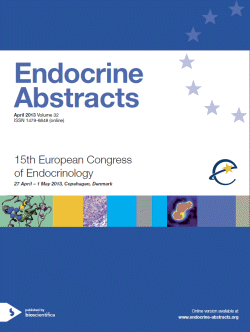Searchable abstracts of presentations at key conferences in endocrinology
Symposia
Translational aspects from comparative to clinical endocrinology
ea0032s7.1 | Translational aspects from comparative to clinical endocrinology | ECE2013
Brain aromatase and endocrine disruptors in zebrafish: from basic to applied research
Aromatase is the only enzyme converting androgens into estrogens, which are key actors in reproductive biology. Teleost fishes have two copies of the cyp19a1 gene, which encode two isoforms of aromatase: cyp19a1a encodes ovarian aromatase, while the cyp19a1b gene encodes brain aromatase. Our recent work showed that, in zebrafish, aromatase B is strongly expressed in a unique brain cell type, the radial glial cells (RGC). In mammals, such cells act as stem cells during embryoni...
ea0032s7.2 | Translational aspects from comparative to clinical endocrinology | ECE2013
Abstract unavailable....
ea0032s7.3 | Translational aspects from comparative to clinical endocrinology | ECE2013
Peptide hormones and receptors: why so many?
Hormones and hormone receptors in mammals, including humans, display bewildering complexity. The evolution of peptide hormone families with multiple members has been difficult to resolve because of their short sequences. Their G-protein-coupled receptor families are challenging because they display variable sequence rates along the proteins, between species, and over time. My laboratory has therefore combined analyses of sequences with investigation of conserved synteny, i.e. ...




